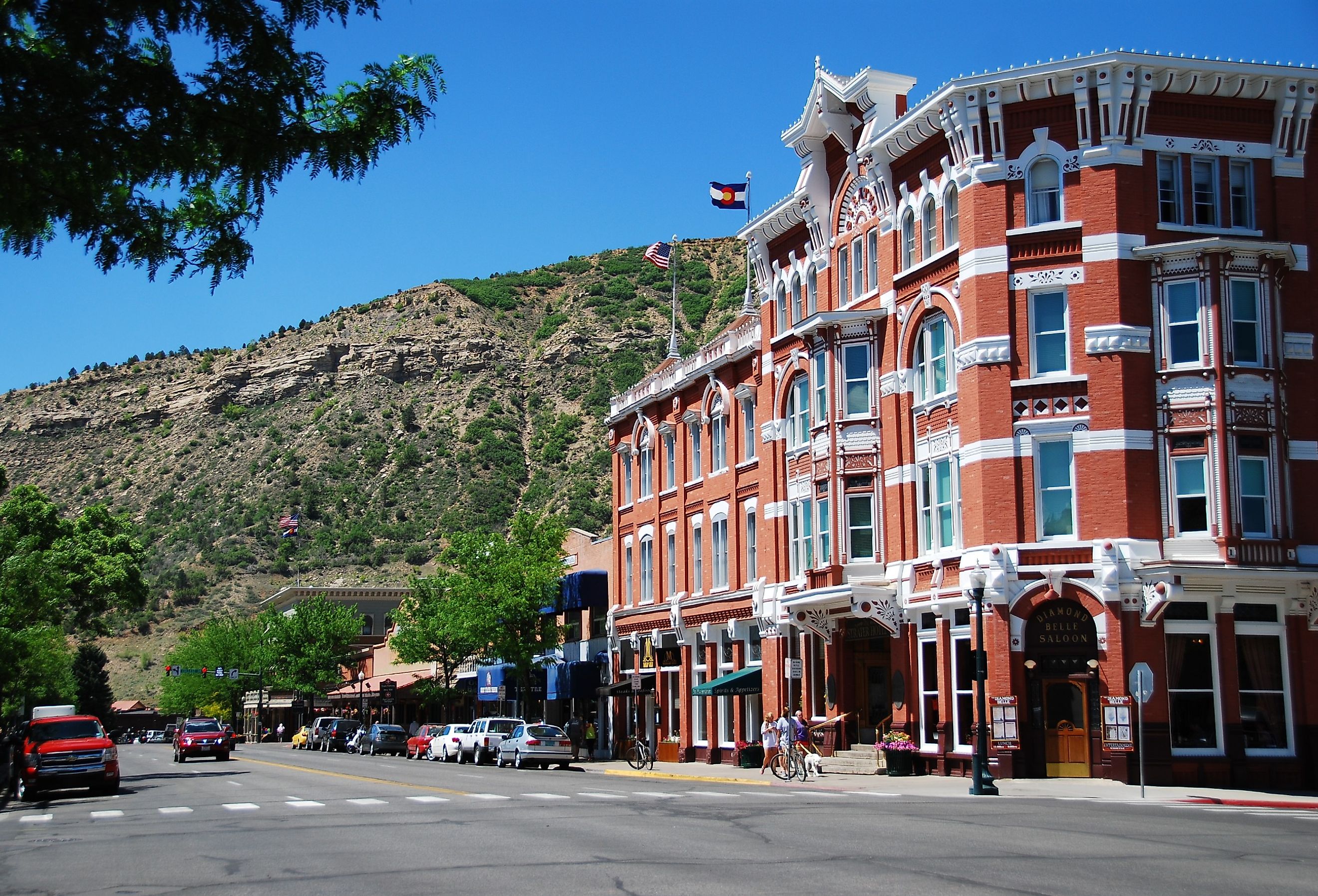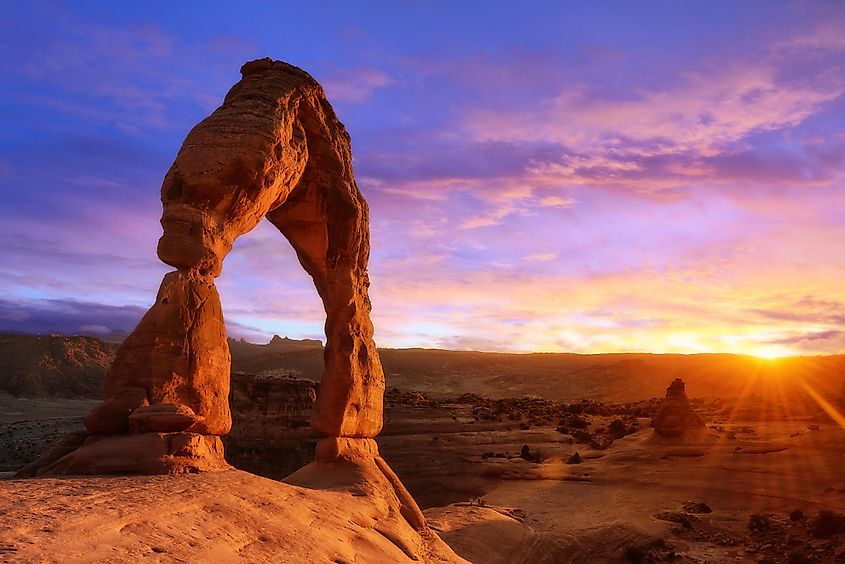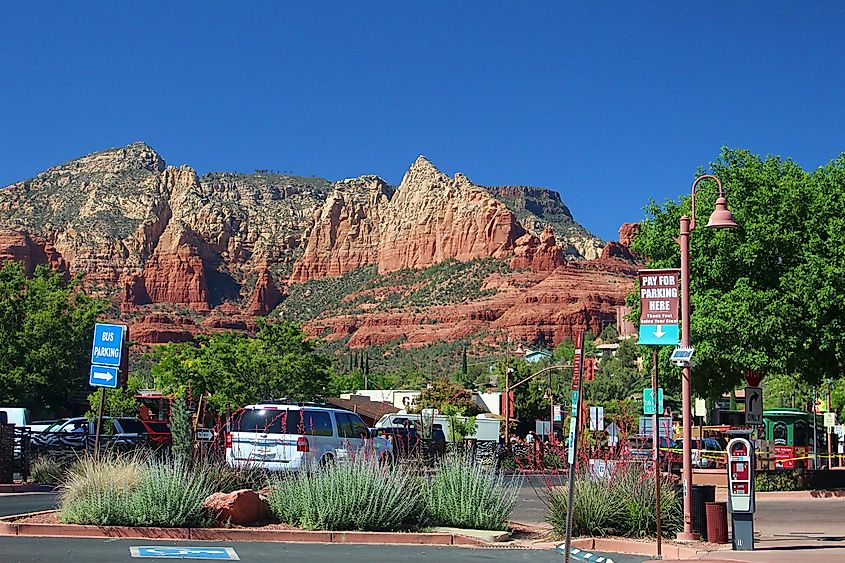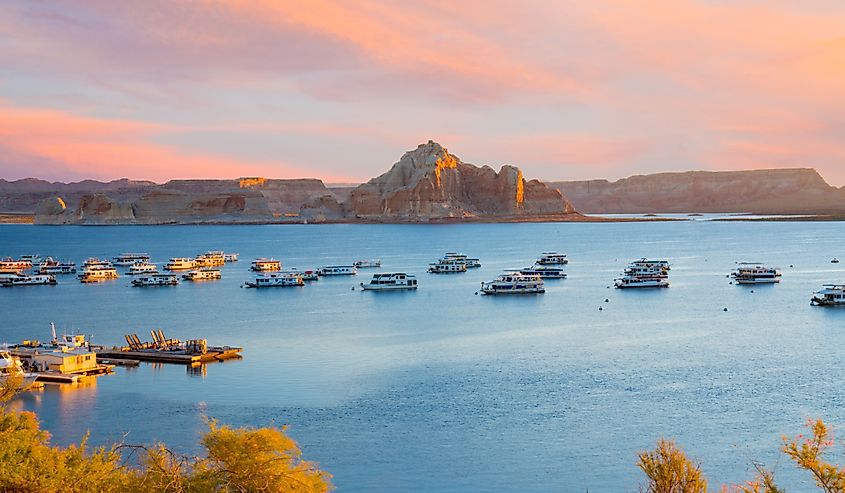
12 of the Most Quaint Small Towns in the Colorado Plateau
Tumbleweeds hop across hot winds and dusty town streets, while red-painted Precambrian mesas loom towards cloudless blue skies. On this wild, western land roam travelers old and new, from gunslinging cowboys and Indigenous peoples to enthusiastic tourists of all walks of life, all climbing from the four corners of the world and from four interconnected states. This is the region known as the Colorado Plateau, rising about 1,200 feet above sea level, with plateau tops ranging from 5,000 to 7,000 feet and mountaintops reaching nearly 13,000 feet.
This 240,000-square-mile land, also called the Four Corners, connects the states of Arizona, Utah, Colorado, and New Mexico in a tight-knit plate laden with natural and historic treats. Ancient volcanoes, plateaus, buttes, weather-carved canyons, and breathtaking ranges the color of a Wild West sunset dominate the Colorado Plateau. But it is the quaint small towns of the region that truly embody the Wild West spirit, where many an American tale was told. So high ho, quicksilver, and chase that sun towards these rugged and rustic small towns of the Colorado Plateau.
Moab, Utah

Better get your harmonica tooting because the small town of Moab is a perfect and atmospheric setting for a Wild West adventure. People rightly call Moab "Nature’s Masterpiece," for the town is part of the red rock landscapes of Arches National Park and Canyonlands National Park, all fed by the silvery waters of the Colorado River. In these nature-painted terrains, you might chance upon familiar scenes from many movies like The Lone Ranger, Indiana Jones and the Last Crusade, and even Galaxy Quest along the many hiking and biking trails.
Stand atop Dead Horse Point State Park, a 2,000-foot elevation that overlooks the Colorado River and the panorama of Canyonlands’ pinnacles and buttes, where cowboys once herded and corralled wild mustangs. During the night, you can gaze up at the uncontaminated backbone of the night to peer at the naked expanse of the Milky Way galaxy, or you can focus your attention on the rocks and caves of the area, where millennia-old rock arts or petroglyphs from Navajo, Hopi, Pueblo, and many other indigenous peoples stamped their legacies to the land.
Sedona, Arizona

Regarded by Native Americans as sacred, Sedona is a magnificent and dynamic mecca for tourists. Home to the amber-bright Grand Canyon, the land around the small town offers plenty of nature-based explorations like the Sedona Wetlands Preserve, the Dead Horse Ranch State Park, Slide Rock, and Oak Creek Canyon. History enthusiasts can be enthralled by the Verde Valley Archaeology Center in Camp Verde, whose exhibits include the Hisatsinom ("Ancient People“ in Hopi), a mural wall depicting the origins and travels of Hopi ancestors in the Sedona and Verde Valley, and information and artworks from the Yavapai and Apache nations who have inhabited the Verde Valley since 2,000 BCE.
Visitors might also be interested in venturing into the Montezuma Castle and Well National Monuments and Tuzigoot National Monument for further appreciation of the Indigenous peoples who have made Sedona and the Grand Canyon their home. Finally, explore the deeper majesties of Sedona’s Red Rocks by attending a hot air balloon tour for an eagle-eye view of the land.
Kanab, Utah

Situated on the southern border of Utah, halfway between St. George and Lake Powell, Kanab is a filmmaker’s ideal setting with its gargantuan Navajo sandstone cliffs and sagebrush vistas, hence why the town proudly proclaims itself as "Little Hollywood." Aside from this moniker, Kanab also takes its name from a Paiute word meaning "place of the willows," and perhaps you can find these willows in the myriad recreational destinations such as Bryce Canyon Grand Staircase Escalante, the Vermilion Cliffs National Monuments, and Zion National Park.
It was in this base camp of Kanab that author Zane Gray wrote his Riders of the Purple Sage in 1912, and where classic Western films such as "The Outlaw Josey Wales," "Sergeants 3," and "Desperate Hours" took place (which you can vicariously tour through the help of the Little Hollywood Museum). Most of all, get a chance to relive that cowboy lifestyle in The Western Legends Heritage and Music Festival, conducted on the third Friday and Saturday of August.
Gallup, New Mexico

Weary from roaming between jagged mesas and over vast plateaus? Then, gallop closer to Gallup for good rest and relaxation. Once known as Na'Nizhoozhi, or "The Bridge" among the Navajo, Gallup thrived as a crossroads for Native American trade before the town’s official inception. To this day, Gallup remains an excellent site of respite for weary travelers as the town is on the Mother Road itself, Route 66, just midway between Albuquerque, New Mexico, and Flagstaff, Arizona.
Stroll through the painted town and gawk at modern murals depicting ancestral pueblos, petroglyphs, and more in the town’s Mural and Arts Walking Tours. Consider attending the Nightly Indian Dances, starting from Memorial Day to Labor Day, or the annual Gallup Inter-Tribal Indian Ceremonial in August. Finally, peruse authentic Native American art from the many tribes—Zuni, Navajo, and Hopi—in the region in the Gallup Native Arts Market or the Gallup Cultural Center, since 70 to 80% of Native American jewelry and art worldwide originates from the area.
Monticello, Utah

Rising 7,000 feet on the eastern slopes of the Abajo Mountains is the town of Monticello. With its impressive height over the Colorado Plateau, visitors get undisturbed views of twelve national parks and monuments surrounding Monticello. Among these tourist destinations are Canyonlands National Park, the Manti-La Sal National Forest, Monticello Lake, Indian Creek, and many more.
One can find the ruins and rubbles of the Anasazi, the Ancient Ones, in the Bears Ears National Monument—a pair of towering buttes that vaguely resemble a bear’s ears—and Hovenweep National Monument, which the ancestral Puebloan people once inhabited from 500 CE to 1300 CE. Perhaps the best preserved and intriguing rock site is in Newspaper Rock, a dark and large sandstone panel in Indian Creek where massive petroglyphs carved by Native Americans—from the ancient Archaic and Fremont cultures to the historic Utes—can be marveled.
Durango, Colorado

As a town established by the Denver & Rio Grande Railroad in 1881, Durango has been bountiful with travelers of all sorts. As a town built by a railroad, Durango is also a hub and waystation for early coal mining enterprises, specifically from the historic and nearby town of Silverton in the 13,000-foot-deep veins of Galena Mountain. Only about 30 minutes from the town of Mancos, Durango provides the fierce San Juan National Forest and rugged La Plata Mountains, awesome terrain marred by hundreds of miles of biking, hiking, and rock climbing trails.
Top attractions include the Durango and Silverton Railroad, Purgatory Resort, and Durango Hot Springs Resort and Spa. The nearby Animas River, Lake Nighthorse, and Haviland Lake are pristine bodies of water that are worth the long trips in nature.
Mancos, Colorado

With close neighbors like Durango and Cortez, the smaller town of Mancos sets a calmer, less populated atmosphere. Because of its close proximity to Durango, it shares many of the nearby natural attractions and amenities, such as La Plata Mountains and the Mesa Verde National Park. Mancos has its own unique natural features apart from Durango, like the Jackson Gulch Reservoir (for fishing) and Mancos State Park (for forested mountain biking and hiking).
Mancos is also the gateway to Mesa Verde National Park, a UNESCO World Heritage Site where some of the darkest and uncontaminated night skies left in the continental United States endure, and where ruins of the Pueblo cave-dwellings linger. In town, be sure to check out the Mesa Verde Visitor and Research Center before heading to the National Park.
Jemez Springs, New Mexico

When you are in the scorching, sun-cooked drylands of the Colorado Plateau, you would normally try to keep cool in a cold place. But in the village of Jemez Springs the bubbling hot springs—primitive and commercial—offer the right kind of warmth you want that will heal your ailments and cool your worries from many a weary travail. Only an hour’s drive from Albuquerque and Santa Fe, people like the local Walatowa pueblo have come to Jemez Springs since 2,5000 BCE, as evinced by archaeological findings at Jemez Cave near Soda Dam.
Spanish missionaries also stayed in the town, and the 16th-century San José de Guisewa (Jemez) church memorializes the Spanish influence in Jemez Springs. Nearby, the Valles Caldera National Preserve provides 89,000 acres of astounding vistas within the dead, depressed remnants of a 13-mile-wide volcanic eruption more than 1.25 million years ago.
Lupton, Arizona

The real-life small town of Lupton provides a mesmerizingly similar atmosphere to the dusty, laid-back, and rustic town in the first Cars movie, Radiator Springs. As a border town between New Mexico and Arizona and with a peculiar population of a couple of dozen locals, Lupton has been a waystation for bikers and other travelers on the legendary Route 66 highway. It was known as Tesesi’ani’ (Setting Rock) and Tsedijooli (Round Rock) to the Navajo, and prior to the establishment of Fort Sumner, New Mexico, Lupton was a central point of departure for military expeditions and supply routes.
The high sandstone bluffs of the Painted Cliffs tower over the tiny and unassuming trading outpost characterize the starkly lonesome magnitude and beauty of Lupton. Admittedly, there is not much about the town that will make one linger long, but like Lightning McQueen in Cars, it is a good place to stop when readying for a bigger journey ahead.
Holbrook, Arizona

Holbrook sits within the Painted Desert, a dazzlingly remarkable and lonely landscape of rocky, striated badlands that stretches from the Grand Canyon to the Navajo Nation. Formed from Chinle Formations—river-related deposits dating back some 200 million years—the multi-hued rocks are mainly located in the remote region of the Navajo Nation. Within these colorful landmarks is the Petrified Forest National Park, where remains of petroglyphs, a hundred-room compound, and an eight-room Pueblo structure, Agate House, can be visited at Puerco Pueblo. The Petrified Forest derives its name from the construction materials for many of the ancient Pueblo buildings in the area, which were made out of petrified wood.
In addition, the Homolovi Ruins are within driving distance from Holbrook. For the town itself, visitors can venture into historical sites such as the Bucket of Blood Saloon and the Blevins House, where a famous shootout between Sheriff Commodore Perry Owens and the Blevins gang took place.
Page, Arizona

Flip a page in your itinerary as you check off a visit to the small town of Page. As a perfect base camp and jumping-off point to some of Arizona’s many natural wonders, Page does not fail to attract many outdoor explorers and Wild West adventurers. Trek through the mesmerizing and labyrinthine sand-sculptured walls of Antelope Canyon, so named for the pronghorn antelope herds that once roamed the area.
Kayak on the placid waters of Lake Powell, the largest man-made lake in the world, or stand atop the cliffs of Horseshoe Bend for a 1,000-foot view of the Colorado River and Glen Canyon Dam. Lastly, brave the sinuous heights and precipices of the Vermilion Cliffs National Monument and Monument Valley for scenic vistas of a region once dominated by the proud Navajo people.
Bluff, Utah

The town of Bluff is not bluffing with its name: along the San Juan River—which winds and bends into “goosenecks” or tight loops in an area aptly called Gooseneck State Park—are indeed towering bluffs that characterize the town’s gargantuan features. Because Bluff is only about 50 minutes from Monticello, it neighbors iconic landmarks like Bears Ear National Monument and Hovenweep National Monument.
However, Bluff is unique in that it is the perfect entranceway to the Trail of the Ancients Scenic Byway, a 116-mile route across jagged, arid, and cultural terrain of the ancestral Puebloan people, where native artistry like the Sand Island Petroglyph Panel can be admired. Furthermore, the town features Fort Bluff, ancient fortifications for Mormon pioneers after their arduous journey along the Hole-in-the-Rock trail.
In a sun-painted land bounded by the Rocky Mountains to the north and east, the Great Basin to the west, and the Sonoran Desert to the south, American legends roamed wild and free. The Colorado Plateau is the birthplace of many swashbuckling Western films and books worldwide, from gunslinging bravados and epic adventures to climactic showdowns and breathtaking action. In familiar sites like Moab and Kanab where tense standoffs took place, or quaint, simple, and peaceful waystations like Lupton and Bluff, there is always something to cherish and remember in Arizona, Colorado, New Mexico, and Utah as you chase the sun or walk beneath the unpolluted, star-filled skies at night. So ride on your quicksilver vehicle down Route 66 or any other route, and prepare to cry “High Ho!” as you run beside darting tumbleweeds and dusty winds towards your own western adventure.











